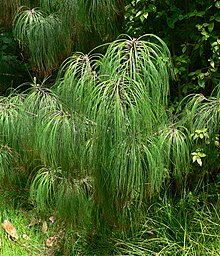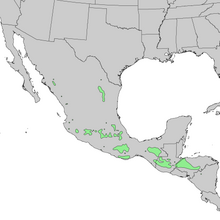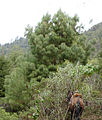bio.wikisort.org - Plant
Pinus pseudostrobus, known in English as the smooth-bark Mexican pine and in Spanish as chamite or pacingo, is a tree found in forests of Mexico and Central America.[1][2][6] [citation needed] It is 8 to 25 m tall with a dense and round top.[citation needed]It is threatened by logging and wood harvesting.[1] The bark is brown and fissured and smooth when young. [citation needed] It is subject to ex-situ conservation.[1] It grows at altitudes between 850 and 3250 m. from 26° to 15° north latitude, from Sinaloa, Mexico to Nicaragua and Honduras. It occurs within a rainfall regime that rains mostly in summer. [citation needed]
| Pinus pseudostrobus | |
|---|---|
 | |
| var. apulcensis in cultivation | |
Conservation status | |
| Scientific classification | |
| Kingdom: | Plantae |
| Clade: | Tracheophytes |
| (unranked): | Gymnosperms |
| Division: | Pinophyta |
| Class: | Pinopsida |
| Order: | Pinales |
| Family: | Pinaceae |
| Genus: | Pinus |
| Subgenus: | P. subg. Pinus |
| Section: | P. sect. Trifoliae |
| Subsection: | P. subsect. Ponderosae |
| Species: | P. pseudostrobus |
| Binomial name | |
| Pinus pseudostrobus | |
 | |
| Natural range of Pinus pseudostrobus. Pinus pseudostrobus is also found in El Salvador.[2] | |
| Synonyms | |
|
Pinus astecaensis Roezl ex Gordon[4] Pinus coatepecensis (Martínez)Gaussen[3] Pinus estevezii (Martínez) J.P.Perry[3] Pinus nubicola J.P.Perry[3] Pinus oaxana Mirov [4] Pinus yecorensis Debreczy & I.Ràcz | |
A stand of about 15 fully mature smooth-bark Mexican pines is in Imperial County, California, at the Palo Verde County Park, in a narrow strip of land between Hwy 78 and the Colorado River. [citation needed]
English botanist John Lindley described the species in 1839. It is divided into Pinus pseudostrobus var.apulcensis (Lindl.)Shaw (Apulco pine), Pinus pseudostrobus f.protuberans Martínez and Pinus pseudostrobus var.pseudostrobus.[2][6]
It has been introduced in New Zealand near sea level and has done well.[citation needed]
- Male cones at San Francisco Botanical Garden
- Pinus pseudostrobus, Cerro Pelón, Mexico
References
- Farjon, A. (2013). "Pinus pseudostrobus". IUCN Red List of Threatened Species. 2013: e.T42404A2977667. doi:10.2305/IUCN.UK.2013-1.RLTS.T42404A2977667.en. Retrieved 16 November 2021.
- "Pinus pseudostrobus". Plants of the World Online. Retrieved 31 March 2021.
- "Pinus pseudostrobus var.pseudostrobus". Plants of the World Online. Retrieved 2 April 2021.
- "Pinus pseudostrobus var.apulcensis". Plants of the World Online. Retrieved 2 April 2021.
- "Pinus pseudostrobus f.protuberans". Plants of the World Online. Retrieved 4 April 2021.
- "Pinus pseudostrobus". iNaturalist. Retrieved 31 March 2021.
На других языках
[de] Pinus pseudostrobus
Pinus pseudostrobus ist eine in Mexiko und Guatemala heimische Pflanzenart der Gattung Kiefern (Pinus).- [en] Pinus pseudostrobus
[es] Pinus pseudostrobus
El pino lacio (Pinus pseudostrobus) es un pino también llamado pacingo y chamite, pinabete en Honduras. Es nativo de México, Guatemala, El Salvador y Honduras[4] donde vive en el bosque templado, a 1300-3250 msnm desde 26° a 15°N. Pinus pseudostrobus fue descrita por John Lindley y publicado en Edwards's Botanical Register 25: Misc. 63. 1839.[5] Pinus: nombre genérico dado en latín al pino.[6] pseudostrobus: epíteto. El pino lacio es altamente variable, sus conos que por lo regular miden 7.6 a 11 cm, llegan a variar desde 3.2 a 16 cm dependiendo de la región y de las características del sitio donde viva.[7] Es utilizado para plantaciones comerciales ya que se aprecia por su follaje semicolgante y aroma agradable a resina.Другой контент может иметь иную лицензию. Перед использованием материалов сайта WikiSort.org внимательно изучите правила лицензирования конкретных элементов наполнения сайта.
WikiSort.org - проект по пересортировке и дополнению контента Википедии


